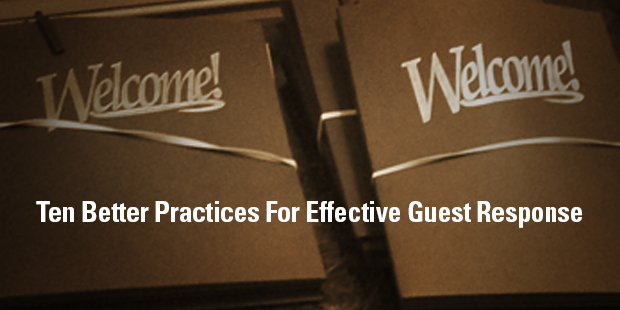
Ten Better Practices for Effective Guest Response
The most-asked questions at each Auxano Guest Experience Boot Camp consistently revolve around recognizing, and hopefully eliciting, some kind of response from First Time Guests. After serving more than 100 churches and campuses while curating Guest Perspective Evaluations, I have observed various styles of church Welcome Team best practices in this arena. Here are a few common forms of Guest recognition that ultimately end in failure to produce a second visit:
The Family Reunion – We are very friendly and love it when we have first timers and they will definitely feel welcomed. But like the “last boyfriend,” we don’t expect them to be here the next time we gather so we do not invest much real effort.
The Sorority Ceremony – We quickly forget that we invited that guy to be Santa at our Christmas Party and leave him in the corner while we conduct some weird “OMG! You got engaged!” ritual. We feel sorry that he was uncomfortable and we wasted his time during exams week, but it’s our house and our rules.
The Eggshell Walk – We work hard to make sure our Guests can remain completely anonymous. However, in consciously sidestepping Guest parking spots or welcome centers, it becomes MORE conspicuous and uncomfortable to visit our campus and wander helplessly around for the first time.
The Humanitarian Relief – We are so tired from keeping the ministry held together and the lights turned on, that whenever a new family visits, they are mobbed like aid workers during a third-world famine. Every smile carries a certain sense of desperation and the hopes that “you are the one” that return us to our former glory.
Here are 10 Better Practices for Effective Guest Response:
- Remember to leave time for them to fill out the card. If you announce the seat/pew-back connection card immediately before the offering plate or another stand-and-sing song starts, people will not have time to fill it out. Think through your service timing and make welcome announcements intentional not automatic.
- Provide pens too. Keep the seats stocked or hand them out at the door. This simple reminder is essential for filling out cards and taking notes on the sermon. Invest in branded pens and invite them to “steal the pens” as long as they leave them for their server at lunch, alongside a generous tip.
- Don’t ask for too much information. Think through how much you are asking for on the connection cards and what you will do with it. Do you really need every data point, or just enough to follow-up the next week?
- Provide your contact information first. Why would a first time guest give you, a somewhat over-caffeinated announcement maker, their cell phone number? List your contact information, whatever you are asking for from them, first. Unless you are ready for them to call you randomly, do not expect to be able to call them randomly.
- Tell them why you want their information. If you need their address or cell phone number, then tell them why. If they know that you are just sending a thank-you note and not going to show up out of the blue some evening, they may be more likely to give it to you.
- Trade them for something. One great way to receive a Guest response is to give Guest swag. Consider a “swap” for the connection card in the form of a Bible, book, teaching resource or other tangible items. But be careful, some churches have gone too far with this idea!
- Tie their response to your vision. What if you choose to invite your Guests into God’s better future, to share in your missional calling, instead of just making the typical announcement? Let them know how their response demonstrates a core value of your church, represents the next step in their spiritual growth, or forms the foundation of long-term disciple-making success.
- Don’t send them to a back room or dark corner. Position any next steps, meet and greet areas, or welcome centers in prime locations within the flow of traffic. Very few people will go against the flow to huddle under the dark balcony stairs – no matter what new swag you have to give them.
- Plan for a multi-dimensional response. Create two to three different opportunities to respond rather than just relying on one card. You should provide online web forms, Facebook group pages and regular discovery classes to attend. Move beyond the worship tear-off card and look for other, natural opportunities to connect. Team up with the Kids ministry and share information about Guest families, as every parent will have given contact information at sign-in.
- Plan the work and work the plan. Think through the entire experience a new family will have at your church, from their first Google search to the ride home. Now think beyond the first visit and how that family will be engaged and growing in Christ at your church. Create a plan and the supporting systems that move people toward God’s better future, one step at a time. Assign one person to have ownership over the entire process, working with and for every ministry.
At Auxano, we use Seven Checkpoints to frame the Guest Experience process from the web to the welcome center. Interested in learning more? Bring a team of up to five leaders to one of our upcoming Guest Experience Boot Camps and learn how to integrate the seven checkpoints, as well as create an intuitive plan to get an excellent Guest response at your church.

Check out Auxano’s Guest Experience Boot Camp in Cincinnati, OH on August 7-8.

Tags: Bryan Rose, Church Guest Experiences, Guest Experience, Guest Experience Boot Camp, Guest response












